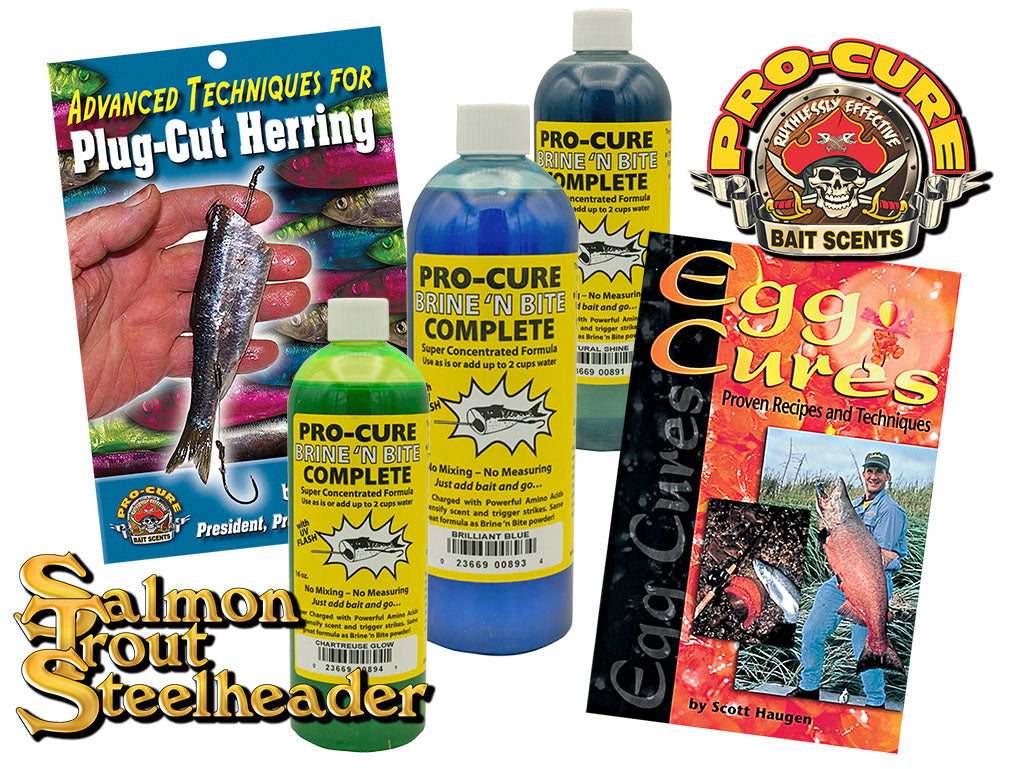Proven Egg Cures Recipes & Techniques
Posted by Susan Carter on
Curing Eggs

"... As you'll read throughout this book, Ramsey agrees that working with clean, blood-free eggs is the first step in obtaining a quality bait. To make your skeins easy to handle, cut each into either three or six manageable pieces. The number of pieces you have will be dictated by the size of the skeins. Large skeins, like those from chinook, can be cut lengthwise first, then divided into three equal sections. When making this cut, be sure to slice the skeins from the open side so that each lengthwise piece will have enough connecting membrane to hold them together. Average size skeins, like those from normal size coho or steelhead need not be split and should be cut into three equal sections. With proper cuts made, place the manageable pieces on butcher paper.
Get a FREE bottle of BRINE 'N BITE by Pro-Cure
PLUS! SAVE 35% using code FALL2023 at checkout
Sprinkle the eggs with a light coating of cure, rolling them in the powder to make certain all surfaces are covered. This is how Mom used to flour chicken. Make sure and get some cure down into each egg layer, then dump all of the baits into a Tupperware container and place in the refrigerator. During this stage, juices will begin to form. If lots of juice is created, gently mix the eggs to encourage reabsorption of the liquid.
"If you're looking for a more durable egg or if you want to reduce the size of overly ripe eggs, you can pour off some of the liquid, which will help toughen them up," offers Ramsey. "After 24 hours of sitting in the refrigerator, when the majority of juices have bled from the eggs, you can add liquid dyes as well as scents. Shrimp, herring, and anise oil are just a few of the choices out there. As for dyes, reds and oranges are popular, but the degree of richness is up to the individual curing the eggs." Introduce dyes and scents once the eggs have created their own juices because at this stage the cells begin reabsorbing lost fluids. The ultimate goal is to have scent and color drawn back into the cells during the plasmolysis phase, thus producing an egg that holds its color, milks well, and distributes scent in the process. 
"I'll keep these eggs curing in the refrigerator for three days," claims Ramsey. "When the time is up, I'll stick the entire container in the freezer. This cure has such a high sugar and salt content that the eggs rarely freezer burn. In fact, I once mistakenly left the lid off an egg container and didn't discover it for months as it was shoved to the back of the freezer. Despite being covered with an inch of frost buildup, they showed no signs of burning. Though this is not the ideal scenario to have happen, it shows how, if mixed accurately, this cure can't go wrong."
Buzz has learned it's best to utilize the eggs from this cure within a year of being processed. He's also observed that when stored in the freezer, chinook eggs appear to outlast other salmon and steelhead eggs treated in this recipe. Buzz is particularly fond of this cure as all eggs from all salmon and steelhead react well to the ratios of ingredients. Ramsey says the eggs put up in this cure can be fished by any method, be it plunking, sidecasting, backbouncing, or working them behind divers.
When preparing to fish these baits, Buzz typically cuts the clusters into desired sizes once he's on the river. "When handling baits on the river, don't be afraid to get a bit of cure on your boat," suggests Ramsey. "One thing I see more and more boat anglers doing lately is placing their cluster in their egg loop, then dropping it over the edge while they clean their hands. Don't do it! Baits are most effective in their first few casts.


